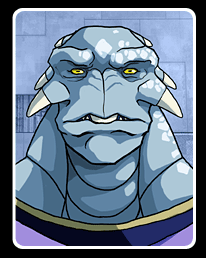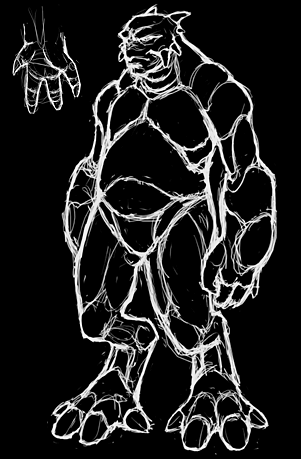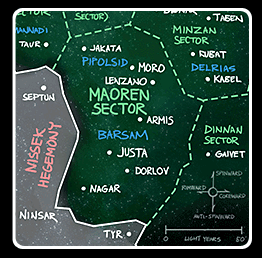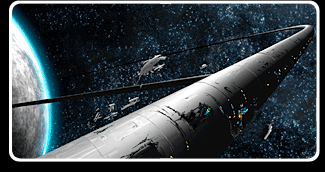|
Data
File Updated:
Friday, December 23, 2022
 Overview Overview
The Barsam
were one of the original founders of the Interspecies Convention
that eventually transformed into the modern Loroi Union, which
they also had a key role in forming. The Barsam share a common
but mysterious origin with the other Soia-Liron species, the
Loroi and Neridi, with whom they are biochemically related. The
current Barsam civilization arose on the arid planet Justa, but
like the other Soia-Liron races, the true origin of the species
is unknown.
Though their size and fearsome physical attributes do make them
formidable warriors, and in the past their ancient ancestors
had a bloody history of internal conflict, today the Barsam
culture is a peaceful one that follows a religion of tolerance
and inclusiveness, preaching that all sentient beings are
brothers and should live in peace. Barsam are renowned for their
ability to successfully cooperate with others, while at the same
time closely guarding their own independence from outside
authority. Though they espouse peace, the Barsam are fierce,
powerful fighters, some of whom do not hesitate to use force
when the occasion calls for it. Barsam are famous for lacking a
sense of humor, and are earnestly serious at all times.
Today, the
Barsam Confederation covers most of the anti-spinward portion of
the Maoren Sector, and Barsam traders and missionaries extend
their influence throughout the Union. They are an important
political force in the Union, sometimes at odds with
the Loroi who otherwise dominate much of the Union's affairs.
The Barsam actively export their culture and religion and its
philosophy of brotherhood, which has at times increased friction
with the militaristic, atheistic Loroi. The Barsam are an
important contributor in the Union war against the Umiak, though most
of their contribution is in terms of industrial, logistical and intelligence support. Together with the Pipolsid and Neridi,
they are also important drivers of Union free
commerce and scientific advancement.
The Barsam native languages are based on
the ancient Trade Language, though the Barsam versions have
diverged much more than their Loroi and Neridi counterparts,
incorporating Barsam-specific vocalizations (including "j", "v" and "tch"
consonants, and the vowel "u"). Although many local dialects are still practiced
throughout Barsam territory, most official business is conducted
in the standardized Loroi version of Trade.
How do
the Barsam write their custom phonemes using the Loroi Trade
script, which does not include these letters?
In several ways. Most Barsam
use a custom version of the Trade script which is readable to
non-Barsam but includes a number of special characters. When
limited to Loroi characters, they transliterate sounds in a
similar way that the Loroi do when encountering unfamiliar
phonemes: (j => z, v => b, u => o, tch => sh). For example, "Shuvo"
would be written in Loroi script as "Shobo."
Biology
The Barsam are large, powerfully built
bipeds with thick, tough, hairless leathery blue skin with white
mottling. They have small yellow eyes with horizontally-slitted
pupils, and their heads and limbs are festooned with bony
spikes. They have clawed four-fingered hands, four-toed digitigrade feet and a stubby vestigial tail.
A healthy adult typically stands 2.3m tall, and weighs in excess
of
 150 kg (330 lbs).
Specimens weighing more than 200 kg (440 lbs) are not uncommon. Barsam
mature rapidly to adulthood as long as they are well fed, and
can enter a state of torpor that increases their regenerative
capabilities, allowing them to recover quickly from injury. They are extremely strong and can
absorb a great deal of punishment. Although they share the
efficient biochemistry of the other Soia-Liron organisms, the Barsam gain greater size and strength and improved
regeneration at the cost of greater nutritional and oxygen
requirements, longer maturation time and reduced lifespan
compared to the Loroi and Neridi. Barsam are omnivorous and typically
consume two large meals per day. Barsam traditionally prefer
forested highland habitats, but they can adapt easily to a wide variety
of biomes. Their powerful jaws are equipped with both narrow
piercing and broad cutting teeth, suitable both for eating meat
and for gnawing through the tough nagen seed pod husks
that were their primary diet on Justa. 150 kg (330 lbs).
Specimens weighing more than 200 kg (440 lbs) are not uncommon. Barsam
mature rapidly to adulthood as long as they are well fed, and
can enter a state of torpor that increases their regenerative
capabilities, allowing them to recover quickly from injury. They are extremely strong and can
absorb a great deal of punishment. Although they share the
efficient biochemistry of the other Soia-Liron organisms, the Barsam gain greater size and strength and improved
regeneration at the cost of greater nutritional and oxygen
requirements, longer maturation time and reduced lifespan
compared to the Loroi and Neridi. Barsam are omnivorous and typically
consume two large meals per day. Barsam traditionally prefer
forested highland habitats, but they can adapt easily to a wide variety
of biomes. Their powerful jaws are equipped with both narrow
piercing and broad cutting teeth, suitable both for eating meat
and for gnawing through the tough nagen seed pod husks
that were their primary diet on Justa.
Barsam are hermaphroditic, with all
adults potentially able to bear children. Lacking external
genitalia, Barsam produce egg-like sacs containing isogametes;
these are exchanged with other individuals and consumed orally,
at which point both individuals may become pregnant and bear
offspring. However, the long 16-month gestation period and the
large amount of food required to properly nourish the
rapidly-maturing infant mean that it was very difficult in a
primitive hunter-gatherer society in a somewhat harsh
environment for each adult to effectively
raise its own offspring alone. Therefore, the Barsam developed a
cooperative family structure, typically consisting of 4-10
individuals, only one or two of which would be impregnated
during the breeding season. The selected individual consumes all of the gamete sacs
produced by the others, and the offspring is raised communally
by the entire group, without knowing which of them are the true
biological parents. (In some of the more barbaric ancient
societies, the partners fought, and the loser was force-fed the
sacs.) In modern times with the abundance of food
that high technology provides, modern Barsam have the resources to reproduce at
will, and live as solitary individuals as often as they do in
traditional family groups.
Births are almost always single infants; if the built-in
safeguards against multiple zygote fertilization fail, the
pregnancy will usually result in a miscarriage. Because Barsam
do not give milk, the baby must be born able to eat solid food
immediately, and can usually crawl within a few days of birth.
If provided with sufficient food, Barsam children grow rapidly,
reaching adulthood in 12 years. Individuals who suffer from
malnutrition during childhood often exhibit dwarfism. Barsam age
more rapidly than the other Soia-Liron species, especially if
they have been subjected to a physically demanding lifestyle.
Advanced deterioration typically sets in around age 150.
The Confederation of Barsam Worlds
Prior to the formation of the Union, the Barsam worlds
existed in a loose confederation, which persists into the
present as a member state of the modern Union. Though the Confederation includes dozens of colonies
and settlements, more than half of the Barsam population lives
on four key worlds: Moro, Dorlov, Armis, and the capital Justa.
Several of their most important settlements (including Moro and
Halli) lie outside Barsam territory proper, which itself lies in
the anti-spinward half of the Union Maoren sector, between the
Pipolsid worlds and the border with the Nissek Hegemony. Smaller Barsam
colonies are spread throughout Union territory, including the Seren and Tinza sectors, and new colonies in the Dinnan
frontier.
 Justa Justa
Justa is a small,
moonless, arid world covered by great mountain ranges
and numerous small lake-sized saline seas. It has no known
native life, and is populated by the descendants of
seeded Soia-Liron organisms, including the Barsam. The highest
altitudes of the mountains are mostly barren; the foothills are
covered in evergreen nagen forests. Flat plains are rare.
The landscape is pocked with ancient impact craters, which form
dry basins at higher elevations, and which are often filled with
water at lower elevations.
Justa was home to a Soia-era colony of Barsam ancestors, and
the caves and tunnels beneath the Lugei mountains preserve many
Soia artifacts. After the fall of the Soia empire, the surface
colony on Justa was destroyed and its survivors reverted to a
hunter-gatherer culture. The ancient crypts would not be
rediscovered until the late iron age, at which point the old shamanistic
religion which had told of ancient ancestors experienced a
resurgence. While the Barsam hill tribes frequently warred with
each other and the lowland tribes, what would become the modern priestly class established
temples in the mouths of the caves and proceeded to unlock the
secrets of the past. Today, Lugei Temple is the holy city of the
Barsam religion, and is located in the same territory as Orman,
the current seat of the Barsam government.
Dorlov
The heartland of Barsam heavy industry resides on Dorlov, an
Earth-sized world which also has a single large moon and an
active metal core, but which is on the outer edge of the
habitable zone of its star. Although it is volcanically active,
most of the surface of the planet is well below freezing and is
covered with a thick sheet of permanent ice; however, there is a
band of lowland regions ringing the equator where a combination
of sunlight, higher atmospheric pressure and volcanic heat have
melted enough ice to expose the rocky surface. These regions are
dotted with meltwater lakes, thermal springs, and extensive mats
of brightly colored native fungal life. The combination of
active vulcanism and regular cycles of glaciation have
concentrated valuable minerals on the surface into easily
accessible deposits, and the ready access to geothermal power
has made it an ideal site for Barsam industry.
Dorlov is the headquarters of Shuvo Industries, one of the
largest Barsam multinational corporations. Among many other
products, they are the preferred suppliers of armored hull
components for Union warships. The company faced some
Loroi-imposed sanctions and suffered a leadership shakeup in
2140 when several high-ranking executives were convicted of war
profiteering and supporting the failed attempt to overthrow the
Loroi Emperor Greywind shortly after she was appointed.
 Armis Armis
Wind-sculpted, barren Armis serves as the hub of Barsam
shipping and shipbuilding. Strategically located at a crossroads
of 11 usable jump links, the planet would be unremarkable were
it not home to the most spectacular Dreiman-era relic in known
space: an orbital megastructure known as the Agumo, which forms
a complete ring around the planet. Using this ruin as a
skeleton, the Barsam have constructed a vast array of orbital
facilities, including habitats, stations, and unparalleled shipyards.
More conventional settlements have also been established on the
planet's surface, including cities with soaring aerodynamic
towers, but as much as one third of the population works and
resides in orbit. Despite the extreme weather driven by its
rapid rotation and the energetic solar wind of its F-type
primary, the planet supports a unique native biome almost all of
which is exclusively airborne, which while not of much practical
economic benefit to the colony, has become famous for the beauty
and daring flying abilities of its fauna (including the famous
winged minnir).
Unsurprisingly, Armis is the capital of the Barsam shipping
industries, and is home to the Agumo Conference, a coalition of
private starship operating firms that could be described as the
closest thing the Barsam have to a mercenary network. Agumo
Conference contractors are available for a variety of work, from
the transportation of high-value cargoes, to deep space
exploration, to dangerous search and rescue or
salvage operations, to contract police and patrol duties. During
the current war, Agumo contractors have provided valuable
services to the Union (Loroi) military in courier, scouting, and
intelligence gathering roles.
Moro
Moro is a temperate world with large oceans, and is the seat
of the Union Assembly. Though the planet was first colonized by
the Pipolsid and still lies in their territory, the planet
also sustains a large Barsam settlement that covers most of the
continental surface (the Pipolsid living mainly in submarine habitats) and
is the most populous Barsam colony outside Justa. Owing to
the presence of the Union Assembly, the idyllic oceanside
capital city of Josetchi is home to a diverse population of
different species from across the Union.
Moro was originally colonized in the distant pre-Soia past by
the Fenrias, who were the ancestors of the modern Delrias. The
rich flora and fauna that proliferate across the planet are
descended from transplanted organisms imported from Kabel, the
Fenrias homeworld. Although these organisms have diversified
greatly in the more than half a million years since the end of
Fenrias habitation, the biome is a more complete example of
Kabel life than can be currently found on Kabel itself, which
was mostly destroyed in the ancient internecine Fenrias wars
that predate the Soia era. The ancient Fenrias colony on Moro was
destroyed with the arrival of the Soia, and ironically
proto-Barsam remains from that time period can be found here,
evidence that the Barsam ancestors fought directly against the
Fenrias to take the planet. The discovery of these remains
served as an important point of contact between the Pipolsid and
Barsam, which later resulted in the close partnership which
led to the joint colony and, eventually, the formation of the
Interspecies Convention and Union.
 Halli Halli
A small temperate world supporting a complex biome of native
life, Halli was surveyed by Loroi colonial teams during their
expansion into the Seren sector in the 1700's CE, and it eventually
became an important logistical base. Loroi plans to
more fully colonize the planet were put on hold when they found
that it was already populated by an intelligent pre-industrial
civilization, which became known as the Nibiren. Though their
tribal stone age culture was not especially remarkable, their
similarity in appearance to the Barsam certainly was. The
Nibiren were smaller than the Barsam and had different
coloration (earth tones instead of Soia blue), and they were of
a very different (local) biochemistry, but they were otherwise nearly
identical in form and appearance. Barsam scientific and
religious entities took an immediate and intense interest in the
planet and its inhabitants. Halli is still under Loroi
jurisdiction (and technically under Loroi occupation), but Loroi
presence was minimal, and aside from the native Nibiren, the
largest foreign settlements on the planet were operated by Barsam
anthropologists and missionaries.
There is ample evidence that show the Nibiren to be a local
evolutionary development of Halli, from the distinct local
biochemistry to the existence of local animals with obvious
shared ancestors (in particular, the smaller, longer-tailed plains-running Diidadi). This discovery was of great religious import to the
Barsam, since it supported the narrative of what has become the
most dominant sect of the Barsam church: that the Barsam were a
created rather than evolved people.
The development plans for Halli have been a point of
contention between the Loroi and Barsam. The Loroi position is
that the Nibiren should be left alone to develop in their own
way. The Barsam feel a duty to help improve the harsh lives that
the Nibiren live, by introducing medicine and agricultural
techniques, and encouraging social and technological innovation.
This has proved easier said than done, as the Nibiren have
significant behavioral differences from the Barsam; they are
more solitary and cope with the rigorous demands
of pregnancy through hibernation rather than cooperative
families, and so have been slow to adopt the more complex social
systems that the Barsam try to teach them. The Loroi have mostly let the Barsam have their own
way in this matter, and the planet is largely administrated by
Barsam agents. Though the permanent Barsam settlements on Halli
are kept small by rule, they are busy hubs of activity by
visiting Barsam scientists, clerics, pilgrims and tourists.
Since the start of the war, the Loroi colony increased greatly
in size, swelled by Loroi refugees fleeing the fall of Seren and
other Steppes colonies. Increasing Loroi demands on local
resources has heightened tensions between them and the Barsam
over impact on the native population.
History: Origins and Pre-Starflight
Archaeological evidence of modern Barsam habitation on Justa
dates back to the time of the fall of the Soia empire c.275,000
BCE, and there is some evidence of proto-Barsam in the depths of
the Soia-era tunnels beneath the Lugei mountains that are
earlier, but difficult to date precisely. Earlier proto-Barsam
remains have been found on other planets, including Moro, which
date to almost half a million years ago.
After the collapse of the Soia interstellar order, the
Barsam survivors on Justa lost most of their high technology,
but began to recover in good order. Unlike the Loroi, whose
post-Fall civilization collapsed entirely into barbarism due to
lack of population controls, the Barsam developed an effective
control with their cooperative family system fairly early on,
and proceeded to advance their culture at a steady pace.
However, the early Barsam were less able to master their own
aggressive nature, and this began a long cycle of the rise and
fall of great civilizations, some reaching almost to the
industrial level before collapsing and reverting to tribalism.
These failures had as much to do with over-exploitation as they
did with warfare, as the substantial Barsam need for sustenance
could easily outpace the capacity of the somewhat fragile and
unproductive Justa ecosystem to provide. Flat lands and ample
fresh water required for the farming of nutritious misesa
grain were scarce on Justa. The nagen seed pods (similar
to pine cones, as tough to eat and about as nutritious) that
formed the staple of the Barsam diet were high in bulk fiber and
relatively low in protein and carbohydrates; it took a huge mass
of such poor foodstuffs to feed a single Barsam, and the
nagen are large trees that could not efficiently be farmed.
The earliest recorded evidence that the Justa Barsam were
aware of the existence of Soia relics in the Lugei Crypts dates to around
10,000 BCE, which marks the beginning of the Barsam priestly
class as it is currently known. Earlier shamanistic clerics who
had maintained an oral tradition of their creation story began
to study the ancient relics, establish hermitages in the caves
and tunnels, and preserve and build on this knowledge using the
ancient Soia writing forms (instead of the newer writing systems
developed by the secular civilizations that rose and fell). For
a long time, this clerical society progressed independently from
the rest of Barsam civilization, at times actively isolating
themselves from the exploitation and destruction of the lowland
and hill tribes. At other times, missionaries from the mountain
temples were sent into the lowlands to attempt to convert their
brothers to the ways of peace and break the cycle of rise and
collapse. During one such cusp, when the hill tribes had again
developed into a near-industrial civilization, the preachments
finally took hold. Following a final titanic series of wars, the
survivors became converts and accepted the leadership of the
clerics, who used their not inconsiderable stored knowledge to
rapidly restore order. One of these clerical leaders was the
prophet Onzir Eutuno, considered the founder of the modern
Barsam church.
With a new ethic of peaceful cooperation and careful
management of resources, aside from a few further bumps along
the road, the Barsam began a slow but steady path of
technological improvement. They developed terraced farming
techniques that allowed productive grains like misesa to
be efficiently farmed even in the foothills. Once their expertise had advanced to
the point where they could more readily comprehend the
implications of the Soia examples that they had studied for so
long, the Barsam were eager to explore the universe. It was a
religious as much as a scientific imperative.
History: Starflight to Union
The Justa Barsam methodically tested unmanned jump-capable
probe ships for many decades prior to their first manned jump in
1067 CE. Not finding any advanced neighbors nearby, they began
to set up outposts to explore more deeply into the unknown, and
a few minor colonies sprang up, the most successful of which was
on Dorlov. The availability of viable jump links mostly led
their exploration efforts anti-spinward, to the edge of the
Great Wasteland and the border of the Nissek Hegemony.
Initial contact with the Nissek was cordial, but before long
the expansionist Nissek were pressuring the Barsam to pay them
regular tribute in return for not expanding into Barsam
territory. The Barsam reluctantly agreed, but began to build up
their own defenses. Through the Nissek, the Barsam learned of
the existence of the Mannadi and other nearby races, including
some who were said to have blue skin and questionable origins.
The Barsam concentrated their explorations toward the spinward
direction, located and claimed the Armis Crossroads, and shortly
thereafter made contact with the Pipolsid, and through them
their allies the Mannadi, Neridi, and Loroi. The Mannadi and
Loroi at that time were at war with the Nissek, and there were
increasing tensions between the various alliance members over
colonial settlement rights. The Barsam and Pipolsid found common
ground in their mutual desire for peaceful cooperation and
became fast friends, and together hosted the First Interspecies
Convention on Moro in 1311 CE in the hopes of preventing future
conflict. This marked the first formal meeting between Loroi and
Barsam officials. Though both were intrigued to learn of their
shared heritage, there was immediate friction between the two
cultures. The Barsam were as alarmed by the naked militarism of
the Loroi as the Loroi were disdainful of the Barsam willingness
to pay tribute to their enemies.
Despite providing a meeting place for all of the known
sentient civilizations of the region, the Interspecies
Convention failed in its aim to prevent war. After the Mannadi
frustrated Nissek attempts to expand into their territory, the
Nissek eventually attacked Barsam colonies near the border, in
spite of the tribute they were being paid. Though the Barsam
were reluctant to fight, they were well-prepared. In what would
be a series of wars fought over the next century, the Barsam
mostly thwarted the Nissek attempts at spinward expansion. The
Barsam colony at Gaivet near the Nissek border
was a flashpoint during several of these conflicts.
The Interspecies Convention also failed to prevent the
ensuing Loroi-Mannadi
wars, but that didn't stop them from continuing to meet
regularly. Like most such international organizations, the
Convention had no real independent authority, because the most powerful nations
were not willing to cede their individual
sovereignty. The Barsam used the Convention as a forum to
express their continual displeasure at the Loroi over their
conduct of the war, and to rally public support against the
Loroi to end the war. In 1555 after the Enok incident and Loroi
reprisals against Mannadi civilians, some of the Barsam
delegates began to call aggressively for war crimes tribunals.
Loroi Azerein Loremark did not respond positively to this
pressure, and it looked for a moment as if there might be a
general war. After several years of intense diplomacy, in 1557
all sides agreed to end the war and to form a mutual Union
government. The Nissek declined to join the Union, but agreed to a treaty of
non-aggression and mutual defense, to respect Union territorial integrity and to
renounce all existing tribute and claims within the new Union
borders. The Loroi required significant concessions in return
for their agreement to join, which left them as the sole de
facto military power in the Union. The Convention was dissolved
and replaced by the Union Assembly.
The discovery of Halli and the Nibiren c.1700 CE drew the
Barsam to establish a presence in the Seren sector. Contact with
the Historians was especially gratifying to the Barsam, to be
able to converse (if perhaps in a limited fashion) with a
culture that seemed so closely connected to the time of their own
"divinely" anointed ancestors. (Indeed, some sects of the Barsam
religion cannot shake the concept that the Historians must be
somehow related to the Gatherers themselves.) The Barsam Armis
shipping magnates and the Agumo Conference established regular
trade routes through the Seren sector and the Steppes; Barsam
traders based at Ukko were among the first Union members to
venture into Umiak ports, and Barsam intelligence agents still
have more prewar experience dealing with the Umiak and their
client states than their Loroi counterparts.
Since the start of the war with the Umiak, the Barsam have
been stalwart supporters of the Union and the war effort. With
the notable exception of some misplaced loyalties at the time of
Emperor Greywind's accession, the Loroi and Barsam have
coordinated closely and successfully. Agumo Conference armed
couriers are active at the front, and joint Loroi-Barsam
colonies in the Dinnan sector have been established in an
attempt to expand Union territory and resources in a direction
away from the Umiak front.
 The Barsam Church The Barsam Church
The Barsam follow one of the few centralized state-sponsored religions in
the Union, the tenets of which govern much of Barsam philosophy
and everyday life. It is an inclusive, pluralistic faith which
advocates peace and brotherhood between all forms of intelligent
life. It has many names and different sects, and so is often
referred to by outsiders simply as the "Barsam Church." It is
actively preached to Barsam and non-Barsam alike by an order of
evangelical troubadour-clerics, who sing sermons of virtue and
cooperation. While the priests themselves do not traditionally
take a direct role in Barsam government, there is no clear
dividing line
between church and state, and most Barsam individuals of
authority or influence are followers of this religion.
At the core of the Barsam religion is an ancient creation
myth that dates back to Barsam prehistory. It goes something
like this: the world is eternal, but is one of many worlds managed by
an order of angelic beings of light known as the "Gatherers" who
dwell in some otherworldly plane of existence that is roughly
analogous to Heaven, connected to our world via a radiant portal
called the Well of Souls. All forms of intelligent life are just
varied manifestations of the same universal soul; all
intelligent life is connected. Over the ages, the world became corrupted,
its peoples living in squalor and strife, and so to remedy this
the immortal Gatherers (who could not speak with or physically interact
with mortal creatures) created mortal servants, in the idealized
image of native peoples, to remedy these ills and bring the
message of truth: that all beings are brothers, and part of the
same holy web of consciousness, meant to live in peace and
cooperation. To this end, the mortal servants
of the Gatherers were armed with great powers, and peace and
order were restored to the world. However, it seems that
Gatherers' servants were too accurate a reproduction, retaining
the flaws of the original peoples. As the ages passed, some of
the servants abused the power they had been given for mortal
gain, and at length the world was again plunged into war and
chaos. Dismayed, the Gatherers withdrew to heaven and closed the
portal, cutting off the means by which the spirits of mortals
could reach ascension. The Well of Souls turned black and became
a maw of all-consuming hunger instead of a font of
life-affirming radiance. All the mortal lands were laid waste,
and the world was plunged into an age of darkness and suffering.
Though most of the early Barsam believed some version of this
tale, they (not unlike the Loroi) were a warrior culture that
was locked in an endless cycle of violence, stagnated in a late
medieval technological era. Then a rebirth occurred, driven by
the spread of a new form of this religion, the most enduring
sect of which was led by the prophet Onzir Eutuno. The prophet taught that though the gate to heaven
was closed and the connection to the Gatherers broken, it could
be restored by embracing the Gatherers' principles of peace and
brotherhood and living by reason and love instead of anger and
violence. This new faith swept across Justa, spread by its
wandering troubadour-clerics (sometimes peacefully, sometimes not
so peacefully), and became dominant in almost every Barsam
subculture. In subsequent generations it became codified as a
formal church.
As the Barsam advanced technologically and discovered
evidence of the ancient precursor empires of the Fenrias,
Dreiman and Soia, and learned of their biological connection to
the Loroi and Neridi, everything seemed to reinforce the truth
of their faith. Modern church scholars have expanded the core myth to a
galactic scale, identifying the Gatherers with the Soia, and
their servants with the Soia-Liron and Dreiman. Even the
telepathy of the Loroi seemed to confirm the tenet that all
intelligent minds share the same soul, and are connected with
each other on a fundamental level. The discovery of the
mysterious supermassive stellar remnant spinward of Historian
territory was quickly identified
with the mythical Well of Souls, the point of entry and egress
of the Gatherers to and from their angelic dimension.
Barsam religion forbids killing and capital punishment, but (as with most Christian
nations) this hasn't stopped them from fighting in their own
defense when they feel
it's necessary. Most denominations forbid the taking of any life and
are strictly vegetarian, but there are a few sects that make an
exception for Soia-liron livestock, reasoning that the Gatherers provided domestic food animals for a
reason. There is no "hellish" underworld nor any
explicit personification
of evil; the Prophet explains that evil is the failure of good
people to live up to their potential and obligations. There are
some versions of the holy texts that name the group of the
Gatherers' servants (the 'Zulotchi') that started the
insurrection against their holy creators, and this name is
sometimes used by the Barsam in a manner similar to English
curses regarding hell or damnation.
The Barsam have many religious texts, but their preachings are mainly
vocal and musical; sermons and prayers are sung. The traditional
instrument of the wandering troubadour-cleric is the stringed
getch, which resembles a large cross between a banjo
and a koto. Clerics can be easily identified by noting
the spikes on their heads which have been ritually filed down to
remove the dangerous points.
Is it unified or is it split up on several
variants that hate each other and throw blasphemer and infidel
accusations around? Are there militant variants? Are there those
that only use it as a source of philosophy and actually ignore
the religious part? And how popular is it, in any variant among
non Barsam? Is it open for
non Soia-Liron species and if so do template species have
special place in the faith?
There is an orthodox version of
the church that is centralized and state-sanctioned; however,
there are numerous alternate sects. Some lean towards the
fundamentalist and extreme, and some lean toward the casual and
philosophical. The official doctrine of the orthodox church (in
the modern era) is to promote its own canonical doctrines, but
to be as inclusive of variant interpretations as much as is
possible. The church aims to gain alien converts, and so it must
try to be flexible. Doctrinal disputes are vigorously argued,
but violence in the modern church is excessively rare.
The church is open to all
sentients, regardless of origin. There is only one known
"template" species, the Nibiren, who the Barsam feel a
duty to help. The Barsam do
view themselves and other Soia-Liron species as "special," but
only in a sense of increased responsibility to be an example and
spread the word of peace and brotherhood. (Even in
Judeo-Christian theology, "angels" are servile creatures
who,
despite being powerful and immortal, are of lower status
than the mortals who they are charged with watching over and
protecting.)
The Barsam church has some
adherents among the other Union races, but they are a minority.
Has the
Barsam religion encountered any other religions that conflict
with it? And if so how have they been met?
Similar in some ways to early
Christian and Buddhist missionaries, the Barsam church tries
earnestly to reinterpret foreign belief systems in ways that are
compatible with the Prophet's narrative. They try to ignore
conflicts and find common points of agreement. In many
starfaring cultures, religion and superstition are waning,
rather than waxing. The Barsam religion is one of the few that
seems to gain strength with new discoveries, rather than being
threatened by them.
See also:
Races of the
Loroi Union and Allies,
Precursor Empires
|
![]()
![]()
![]()
![]()


 150 kg (330 lbs).
Specimens weighing more than 200 kg (440 lbs) are not uncommon. Barsam
mature rapidly to adulthood as long as they are well fed, and
can enter a state of torpor that increases their regenerative
capabilities, allowing them to recover quickly from injury. They are extremely strong and can
absorb a great deal of punishment. Although they share the
efficient biochemistry of the other Soia-Liron organisms, the Barsam gain greater size and strength and improved
regeneration at the cost of greater nutritional and oxygen
requirements, longer maturation time and reduced lifespan
compared to the Loroi and Neridi. Barsam are omnivorous and typically
consume two large meals per day. Barsam traditionally prefer
forested highland habitats, but they can adapt easily to a wide variety
of biomes. Their powerful jaws are equipped with both narrow
piercing and broad cutting teeth, suitable both for eating meat
and for gnawing through the tough nagen seed pod husks
that were their primary diet on Justa.
150 kg (330 lbs).
Specimens weighing more than 200 kg (440 lbs) are not uncommon. Barsam
mature rapidly to adulthood as long as they are well fed, and
can enter a state of torpor that increases their regenerative
capabilities, allowing them to recover quickly from injury. They are extremely strong and can
absorb a great deal of punishment. Although they share the
efficient biochemistry of the other Soia-Liron organisms, the Barsam gain greater size and strength and improved
regeneration at the cost of greater nutritional and oxygen
requirements, longer maturation time and reduced lifespan
compared to the Loroi and Neridi. Barsam are omnivorous and typically
consume two large meals per day. Barsam traditionally prefer
forested highland habitats, but they can adapt easily to a wide variety
of biomes. Their powerful jaws are equipped with both narrow
piercing and broad cutting teeth, suitable both for eating meat
and for gnawing through the tough nagen seed pod husks
that were their primary diet on Justa.
 Armis
Armis Halli
Halli The Barsam Church
The Barsam Church